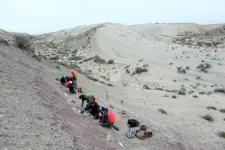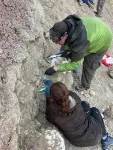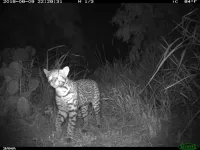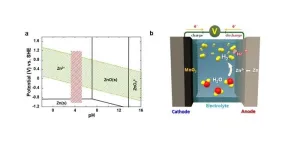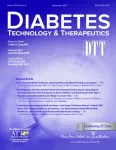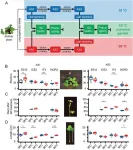(Press-News.org) Release No. 23-35
Contact: Justin Samuel
+1-303-357-1026
jsamuel@geosociety.org
Contributed by Emily Zawacki
Pittsburgh, Pa., USA: The discovery of a spectacular fossil site in Argentina is helping shed new light on life at the end of the Cretaceous, the time period just before the non-avian dinosaurs went extinct. New research presented this Monday at the Geological Society of America’s GSA Connects 2023 meeting by Matthew Lamanna, a paleontologist and the principal dinosaur researcher at Carnegie Museum of Natural History, describes exciting fossil finds from a site known as the Cañadón Tomás Quarry in southern Argentina’s Patagonia region.
“In general, dinosaurs and other continental vertebrates from the Cretaceous tend to be less known from the Southern Hemisphere than they are from the Northern, and that creates an imbalance in our understanding of biodiversity, evolution, and paleobiogeography,” says Lamanna. “We know enough about continental vertebrates in the Late Cretaceous to know that there were some very different kinds of animals thriving in the Southern Hemisphere. One thing that we'd really like to know is, how did non-avian dinosaurs in the southern half of the world fare at the Cretaceous-Paleogene boundary?”
The Cañadón Tomás site was first discovered in early 2020 due to petroleum interest in the region. Oil companies were required to carry out a paleontological impact study before they could begin work, and the study soon uncovered dinosaur fossils.
“The paleontological impact study was done by people from the Museo de La Plata and they found some bones belonging to hadrosaurs (large-bodied duck-billed dinosaurs). This information was shared with the paleontology crew of the Universidad Nacional de la Patagonia San Juan Bosco (UNPSJB), who started to explore the area, finding some bones. At the end of 2020, a few bones were recovered in the outcrop that today is Cañadón Tomás, and little by little, we began to expand that excavation hoping to find something interesting,” says Noelia Cardozo, a PhD student at the UNPSJB and member of the Cañadón Tomás research team.
Continued excavations at the site have revealed dozens of bones from hadrosaurs. These plant-eaters are common and well known in Northern Hemisphere sites from Late Cretaceous times, but they are comparatively rare and poorly known from Southern Hemisphere sites. Interestingly, the hadrosaur fossils at Cañadón Tomás appear to belong to individuals of multiple sizes.
“The site could capture a social group, potentially even a herd of individuals that were related to each other that were all buried together. These are the kinds of things that we’ll be investigating as we dig into the site more,” says Lamanna.
In addition to the hadrosaur fossils, the team discovered the remains from two individuals of non-avian predatory dinosaurs: a tooth, likely from an abelisaurid, and a claw, likely from a noasaurid or a baby abelisaurid.
While the dinosaur fossils at Cañadón Tomás are exciting and provide crucial insight into Southern Hemisphere non-avian dinosaurs before their extinction, it’s other fossil finds of rare and small-bodied vertebrates that have the research team most excited.
The team discovered a vertebra of a snake, likely a madtsoiid, the first Cretaceous snake found in this region of Patagonia known as the Golfo San Jorge Basin. What really put the site high on their radar, according to Lamanna, was the discovery of the upper jaw containing teeth of a small mammal known as a reigitheriid.
“For me, the most exciting discovery from this site so far was the small fragment of the jaw of a mammal,” says Cardozo. “Because this formation is mainly well known for its record of dinosaurs, that’s what I expected to find. But when that little piece [of jaw] appeared, we knew it was different from everything that we had been working on so far.”
In March 2023, Cardozo and fellow UNPSJB student Ivanna Mora had spent only two hours sieving through rocks and sediment when they discovered the mammal jaw—relatively speaking, a lightspeed find in the world of paleontology. The fossil is now the first Cretaceous mammal of any kind found in the Golfo San Jorge Basin. According to Lamanna, the jaw is “one of the best fossils of its kind of mammal ever discovered.”
Mammals in the Cretaceous were typically small, rodent-sized creatures—not as foreboding and as easy to capture the imagination as dinosaurs. However, understanding mammalian life at the end of the Cretaceous is crucial to having a full picture of life leading up to the extinction of non-avian dinosaurs, as well as understanding how mammals expanded and proliferated following the extinction.
While research and excavations at the Cañadón Tomás site are still in a preliminary stage, the fossil discoveries thus far have shown that the site is extremely promising.
“Cañadón Tomás is a site of great interest not only for the great diversity, but also for the great quantity of materials that are being discovered at the site,” says UNPSJB Ph.D. student Bruno Alvarez. “As excavation work continues, more and more materials are being found. There is still a lot of work left to do at Cañadón Tomás with a lot of field work to complete, and we suspect there will be many more fossils to discover and study.”
Lamanna notes that people should “keep their eyes peeled for new discoveries” from Cañadón Tomás.
“We think [Cañadón Tomás] holds so much potential to not only inform our understanding about Cretaceous-Paleogene faunal dynamics and extinction dynamics in the Southern Hemisphere, but it’s probably also going to produce new species of animals. Right now, it’s one of the sites I’m involved with that has me the most excited and fired up,” says Lamanna.
Leer en español.
Extraordinary New Fossil Locality Casts Light on Central Patagonia’s Last Cretaceous Continental Vertebrates
Contact: Matthew Lamanna, LamannaM@carnegiemnh.org
71: D22. Recent Developments in Biogeography and Biostratigraphy
Mon., 16 Oct., 9:50–10:05 a.m.
The Geological Society of America (https://www.geosociety.org) unites a diverse community of geoscientists in a common purpose to study the mysteries of our planet (and beyond) and share scientific findings. Members and friends around the world, from academia, government, and industry, participate in GSA meetings, publications, and programs at all career levels, to foster professional excellence. GSA values and supports inclusion through cooperative research, public dialogue on earth issues, science education, and the application of geoscience in the service of humankind.
###
END
New South American site reveals extraordinary fossils from the end of the age of the dinosaurs
New research presented at GSA Connects 2023
2023-10-13
ELSE PRESS RELEASES FROM THIS DATE:
How an ancient society in the Sahara Desert rose and fell with groundwater
2023-10-13
Contributed by Emily Zawacki
Pittsburgh, Pa., USA: With its low quantities of rain and soaring high temperatures, the Sahara Desert is often regarded as one of the most extreme and least habitable environments on Earth. While the Sahara was periodically much greener in the distant past, an ancient society living in a climate very similar to today’s found a way to harvest water in the seemingly dry Sahara—thriving until the water ran out.
New research that will be presented Monday, 16 Oct., ...
Most Canadians with arthritis and disabling chronic pain are in excellent mental health
2023-10-13
Toronto, Canada
A new study published by researchers at the University of Toronto indicates a very high level of resilience among Canadians with arthritis whose activities were restricted due to pain.
The vast majority (76%) of these individuals were free of any mental illness in the past year, including depression. The paper was published online this week in PLOS ONE.
More than half (56%) of the respondents went beyond just being free of psychiatric disorders to achieving excellent mental health. ...
Caution, ocelot crossing: special wildlife exits on busy roads help protect endangered cat
2023-10-13
The Texas ocelot (Leopardus pardalis albescens) is endangered due to historic hunting, habitat loss, inbreeding, and traffic collisions. Today, only between 50 and 80 ocelots remain in the US, exclusively in Willacy and Cameron counties in southern Texas. These two populations are isolated from the larger one in northwestern Mexico by highways and urban development.
“Here we show that a range of species, including middle-sized carnivores such as bobcats and coyotes, successfully use wildlife exits, a new type of mitigation structure specifically designed for the US endangered ...
A cheaper, safer alternative to lithium-ion batteries: Aqueous rechargeable batteries
2023-10-13
This summer, the planet is suffering from unprecedented heat waves and heavy rainfalls. Developing renewable energy and expanding associated infrastructure has become an essential survival strategy to ensure the sustainability of the planet in crisis, but it has obvious limitations due to the volatility of electricity production, which relies on uncertain variables like labile weather conditions. For this reason, the demand for energy storage systems (ESS) that can store and supply electricity as needed is ever-increasing, but lithium-ion batteries (LIBs) currently employed in ESS are not only highly expensive, but also prone to potential fire, so there is an urgent need to ...
Most accurate test to date developed to measure biological aging
2023-10-13
A team of European researchers has developed a new test that can accurately measure biological aging in a clinical setting. The discovery was made while studying patients for the aging effects of chronic kidney disease.
The new test is an epigenetic clock – a type of biochemical assessment that looks at DNA to understand how well the body is aging in contrast to its chronological age – and is the first of these cutting-edge tests to be proven to perform accurately in a clinical setting, in ...
International experts push for innovation to improve stroke recovery
2023-10-13
Scientists from The Florey are among the world’s leading stroke experts who have mapped out how researchers and clinicians can improve outcomes for people who have survived a stroke.
The third Stroke Recovery and Rehabilitation Roundtable, an initiative of the International Stroke Recovery and Rehabilitation Alliance, has made a series of key recommendations about managing fatigue, measuring mobility, harnessing non-invasive brain stimulation technologies and improving how trials are designed. The highly influential gathering of world stroke experts published their findings in a special ...
Using closed-loop in type 1 pregnancy associated with type 1 diabetes
2023-10-13
A new study endorses closed-loop use in type 1 diabetes pregnancy and highlights how the technology can facilitate positive pregnancy experiences. The study is published in the peer-reviewed journal Diabetes Technology & Therapeutics (DTT). Click here to read the article now.
Julia Lawton, from the University of Edinburgh, and coauthors, on behalf of the AiDAPT Collaborative Group, interviewed closed-loop participants in the Automated insulin Delivery Amongst Pregnant women with T1D (AiDAPT) trial. “Women described how closed-loop lessened the physical and mental demands ...
A step towards understanding early interventions for Huntington’s Disease
2023-10-13
Huntington’s Disease is the most common neurodegenerative disorder controlled by a single gene and is characterized by motor and cognitive deficits and psychiatric symptoms. Currently, no treatments can stop or reverse the disease, but new research from Boston Children’s Hospital suggests that there might be a way to protect the brain and prevent or slow cognitive decline.
Research from the lab of Beth Stevens, PhD suggests that parts of the immune system – complement proteins and microglia – mediate the loss of specific synapses connecting the brain’s cortex and striatum. The findings, recently published in Nature Medicine, could ...
Landmark publication calls for increased attention to workplace mental health
2023-10-13
A landmark scientific article on the workplace as a major determinant of health is published today (Thursday, 12 October) in The Lancet, and reveals a global picture of the work-related causes of mental health conditions.
Carried by University College Cork (UCC) researchers for the Lancet Series on work and health, the paper illustrates that major progress in population health can be made by an increased focus on improving people’s work environments.
The paper, ‘Work-related causes of mental health conditions and interventions for their improvement in workplaces’, ...
DNA methylation: The hidden mechanism enabling plants to adapt in a warmer world
2023-10-13
As global warming continues to redefine ecosystems, plants are increasingly tasked with swift adaptation to ensure their survival. One primary mechanism facilitating such rapid adaptation is epigenetic memory, specifically DNA methylation. DNA methylation, a form of epigenetic modification, involves the addition of a methyl group to the cytosine bases of the DNA, altering its accessibility in chromatin and modulating gene expression. In the context of a warming climate, changes in DNA methylation can be triggered by environmental factors like increased temperature. Such epigenetic adaptations ...
LAST 30 PRESS RELEASES:
The Lancet: COVID-19 vaccine hesitancy decreased over time, though mistrust persists among certain groups, study of over 1 million people in England suggests
Psychosis patients ‘living in metaphor’ -- new study radically shifts ideas about delusions
Clinical trial in Ethiopia targets the trachoma scourge
Open-sourcing the future of food
Changes in genetic structure of yeast lead to disease-causing genomic instabilities
UC San Diego Health Sciences Grant Writing Course helps launch successful research careers
Study: Many head and neck cancer trials end early. Why?
Tufts vice provost for research named Foreign Fellow of Indian National Science Academy
New model improves prediction of prostate cancer death risk
Two wrongs make a right: how two damaging variants can restore health
Overlooked decline in grazing livestock brings risks and opportunities
Using rare sugars to address alcoholism
Research alert: New vulnerability identified in aggressive breast cancer
Ruth Harris honored with SSA Distinguished Service Award
Treasure trove of data on aging publicly accessible
Trees4Adapt project to address risks from climate change and biodiversity loss through tree-based solutions
Nature Communications study from the Lundquist Institute identifies molecular mechanism underlying peripartum cardiomyopathy
Pennington Biomedical’s Dr. Gang Hu appointed to NIH Reproductive, Perinatal and Pediatric Health Review Group
World-first project shows great promise to treat low eye pressure
New technique puts rendered fabric in the best light
Brain cancer digital twin predicts treatment outcomes
Cat disease challenges what scientists thought about coronaviruses
Paulson Family Foundation makes an additional $19 million donation to Hebrew University to fund a new building for electrical engineering. Together with its previous gift brings the total donation to
Canada–Estonia partnership advances community-centered clean energy
Sandia’s economic impact sets record for 17th consecutive year
Researchers uncover how tumors become resistant to promising p53-targeted therapy
Aligning games and sets in determining tennis matches
UOC research team develops method to evaluate apps for treating depression
Extreme heat waves disrupt honey bee thermoregulation and threaten colony survival
New brain study explains how binge drinking contributes to long-lasting negative feelings
[Press-News.org] New South American site reveals extraordinary fossils from the end of the age of the dinosaursNew research presented at GSA Connects 2023
